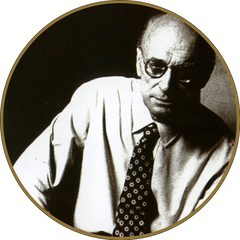Carlo Mattioli biography

Carlo Mattioli, born in 1911 in Modena, was a renowned Italian painter. His family moved to Parma in 1925, where Carlo Mattioli spent the rest of his life. He began his artistic training at the 'Istituto d'Arte' and later dedicated himself to painting, inspired by the experience of artists like Giorgio Morandi.
In the Forties and Fifties, Carlo Mattioli stood out for his suggestive figurative tonalism. During this period, he developed culturally and showed an interest in literature and poetry, establishing a deep connection with Attilio Bertolucci and Mario Luzi. He also began working as a book illustrator, producing engravings and lithographs for artworks by authors such as Pietro Aretino, Stendhal, Guido Cavalcanti and Machiavelli.
In the 1960s, Carlo Mattioli achieved success and established himself with the general public. His production is characterized by a continuous search for new expressive forms, exploring the possibilities of the pictorial language through thematic cycles. During this period, he creates series of paintings such as Nudes, Still Lifes, and Studies on Caravaggio's Basket, obtaining important recognitions such as the Fiorino Prize in Florence in 1964 and the appointment as a member of prestigious academies.
In 1970, his first retrospective exhibition was organized in Parma, which was later also shown in Carrara. In the 1970s, he continues to explore new expressive forms, focusing on the representation of nature and emotions. He creates paintings of beaches, fields of poppies, lavenders, and broom, experimenting with a wide range of painting techniques and using different colors to convey suggestive atmospheres.
In the 1980s, while many Italian artists focus on social themes, Carlo Mattioli's poetics remain faithful to his personal vision of the world. His paintings express wonder at the beauty of nature and the existential unease of the human being. During this period, he creates a surprising series of paintings inspired by Aigues Mortes, exploring the boundary between organic and inorganic, life and death. He also begins to paint tender portraits of his granddaughter Anna, creating artworks that seem like a fairy tale invented to involve the child in discovering the world.
Also during this period, his artworks are enriched with new subjects such as Green Woods, Walls, and Pine Forests. He continues to explore new painting techniques and uses unusual surfaces to apply his colors, such as pages from ancient manuscripts and old worn canvases. His artwork becomes a sort of alchemical transmutation, where old and new forms interpenetrate, respecting their mutual essences. Throughout his career, Carlo Mattioli receives numerous recognitions and his artwork continues to be the subject of retrospective exhibitions in Italy and abroad.
After his death in 1994, the Carlo Mattioli Archive was created in Parma to oversee the authenticity of his artworks and promote their knowledge. His artistic production established him as one of the most important figures in post-war Italian figurative art.



